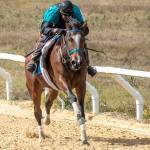Shin Soreness in Young, Intensely Worked Horses

Despite meticulous care and attention to soundness, young racehorses are often sidelined by shin soreness, known also as “bucked shins” or “shinny.” Characterized by fatigue and microfractures on the fore cannon bones, a region called the dorsal metacarpus, the disease is common in two-year-olds and occurs with less frequency in three-year-olds.
About 70-80% of two-year-olds in one older study were diagnosed with shin soreness, and nearly all of those injuries occurred during race preparation that required fast work.*,** A period of reduced fast work or rest is usually warranted following diagnosis, but nearly all horses return to work following resolution of soreness.
In a study conducted by Kentucky Equine Research, the relationship between bucked shins, blood parameters, and cannon bone measurements was studied in 30 Thoroughbreds as they were prepared for two-year-old in training sales.+ The horses were in moderate to intense exercise, and the study period lasted 56 days.
Each horse galloped four days, breezed once, and then either lightly jogged or rested two days each week. Radiographs of the dorsal and lateral metacarpal were taken monthly, and bone measurements were made from these images. Bone mineral content was measured. Plasma levels of calcium, phosphorus, and osteocalcin were also measured. Synthesized by osteoblasts, or specific bone-building cells, osteocalcin was measured in plasma as a biochemical indicator of bone formation.
During the study, five of the 30 two-year-olds displayed clinical signs of bucked shins following breezing, namely swelling, heat, and soreness of the cannon bone.
Researchers observed that two-year-olds with shin soreness do not produce as much bone in the dorsal metacarpal region as normal or unaffected horses. Despite increased osteocalcin levels in plasma, bone width and total bone mineral content was reduced. The horses in the study were managed similarly, so the reason for these differences is unclear.
Young athletes in intense training benefit from a nutritionally balanced diet that includes high-quality forage and a well-fortified concentrate formulated for performance. In addition to these, strategic supplementation is also appropriate.
Triacton contains a novel source of calcium shown to be more highly digestible than other forms of the mineral, including calcium carbonate. Coupled with calcium, Triacton features other bone-building nutrients, including magnesium, boron, silicon, iodine, zinc, and manganese, as well as vitamins A, C, D, and K, all of which are important for bone health.
Studies conducted at Kentucky Equine Research with Triacton demonstrated an increase in bone density among Thoroughbreds in race training. Horses receiving 120 grams per day of Triacton for 90 days had a threefold greater increase in shin bone density compared to horses that received a placebo.
Aside from its benefits to skeletal health, Triacton supports digestive health through its buffering properties in the stomach and hindgut.
*Norwood, G.L. 1978. The bucked shin complex in Thoroughbreds. In: Proc. American Association of Equine Practitioners 24:319-336.
**Buckingham, S.H.W., and L.B. Jeffcott. 1990. Shin soreness: A survey of Thoroughbred trainers and racetrack veterinarians. Australian Equine Veterinarian 8(4):144-153.
+Pagan, J.D., L. A. Lawrence, and D. Nash. 2007. The relationship between bucked shins, blood parameters and cannon bone measurements in Thoroughbreds being prepared for two-year-olds in training sales. In: Proc. Equine Science Society 20:88-90.








